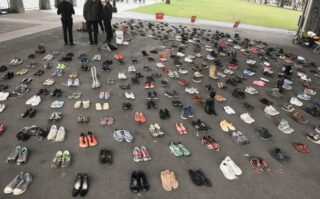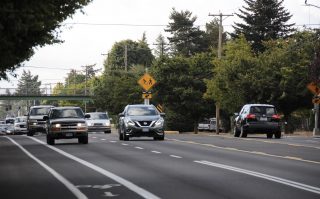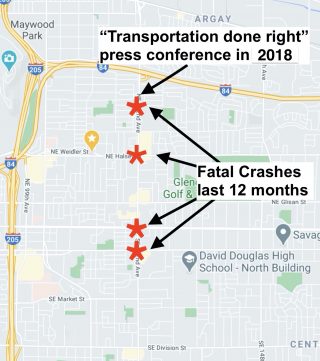
(Photos: Jonathan Maus/BikePortland)
Late Thursday night someone died while using 122nd Avenue. They were the 46th person whose life ended while traveling on a Portland road so far this year, putting us on the same grim pace as 2019 despite a major reduction in travel due to the pandemic.
There have been four fatal crashes in a one mile stretch of 122nd Avenue in the past year alone. In 2018 I attended a press conference marking the completion of new crossings and other updates to the notoriously deadly street. Standing just one block from one of this year’s deaths, Portland Bureau of Transportation Commissioner Chloe Eudaly, PBOT Director Chris Warner, and other transportation bigwigs gave glowing speeches about their dedication to Vision Zero. Eudaly said the recent changes they made were an example of “transportation done right” and how she wasn’t willing to accept the constant carnage on 122nd.
But even on that day just over two years ago it was clear the measures taken by PBOT would not be enough. “It will take much more to tame the wide and fast 122nd Avenue,” I wrote in my recap of that event, “Even with the crowds and cameras at the newly updated NE Stanton intersection this morning, I still saw close calls and aggressive driving.” The good news is PBOT isn’t done with 122nd. In January they won a $4.5 million grant from Metro (via federal funds) to make more changes that should be coming soon.
Advertisement

But will the changes to 122nd be aggressive enough to stop the bleeding? If PBOT’s past performance is any indication, I’m afraid they won’t be.
It’s simple: If we want fewer people to die on our roads, we must make more dramatic changes to street designs that will force people to drive less and drive slower. Incremental improvements fail because the threat evolves much faster than the steps we take to mitigate it.
This Sunday is the annual World Day of Remembrance for Road Traffic Victims. The event was started by United Nations decree in 2005 and it has helped spark a global movement to make roads safer. This morning PBOT issued a statement about it. “We are honoring World Day of Remembrance through message boards. Look for them on Portland-area streets this weekend.”
Message boards.
My son Seamus died ten years ago today. This is the last photo of him – snapped on a flip phone by my husband at our neighborhood park, 2 hrs before they were struck by a careless driver in a crosswalk. He sent it w/ a text that said, "He knows 'uphill' and 'downhill' now!" 1/8 pic.twitter.com/8IeQ3W36Sk
— Michelle DuBarry (@DuBarryPie) November 9, 2020
This past Monday, north Portland resident Michelle DuBarry shared a heartbreaking Twitter thread about her 22-month-old son who was hit by a driver and killed while walking across North Lombard and Interstate in 2010. “Cars are the #1 killer of children in the U.S. – I wish we could muster more outrage at this fact,” she wrote. “The intersection remains a literal death trap.”
People drive so fast and recklessly through places like Interstate and Lombard — and 122nd and Burnside where that person died last night — that they won’t even see a message board, much less a human in their path.
It’s important to remember people we’ve lost. Each one is a tragedy. But let’s also remember that a commitment to safe traffic won’t work if we continue to make safe choices.
— Jonathan Maus: (503) 706-8804, @jonathan_maus on Twitter and jonathan@bikeportland.org
— Get our headlines delivered to your inbox.
— Support this independent community media outlet with a one-time contribution or monthly subscription.


